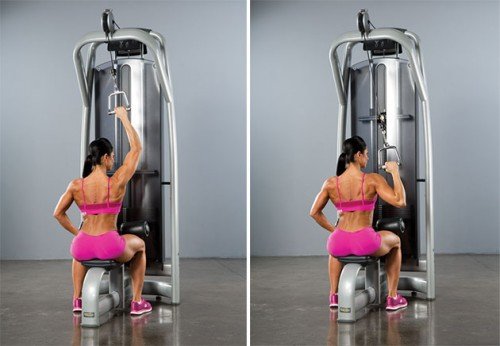How To Do: Single-Arm Lat Pull-Down

Pulldown exercises are typically performed on a cable machine, with both arms pulling a bar downward. By attaching a handle to a high pulley, however, you can do pulldowns with one arm at a time. You engage more muscle fibers with single-arm than double-arm exercises, so you can lift heavier weights and make greater strength gains. Additionally, single-arm exercises prevent your stronger arm from doing more than half the work. To fit single-arm pulldowns into your exercise plan you must understand which muscles the activity targets.
Form
Single-arm pulldowns are fairly straightforward exercises, but it’s still important to use proper form to gain the greatest benefits and to avoid an injury. Attach a handle to a high pulley machine. Grasp the handle with your palm facing the machine, then sit down in the machine’s seat with your feet flat on the floor. Your arm should be extended fully as you begin. Exhale as you pull the handle down to the side of your upper chest, then inhale as you return, under control, to the starting position.
Target Muscles
Pulldowns are commonly known as “lat pulldowns” because the exercise targets the latissimus dorsi muscles, or lats, at the sides of your back and below your shoulders. Both double-arm and single-pulldowns focus on the lats. These muscles are involved in a variety of shoulder and shoulder-blade movements. For example, your lats feature prominently in swimming, climbing and rowing motions. Leaning back a bit while you’re doing single-arm pulldowns helps you work your lats even harder. Lean back about 45 degrees to shift the focus across your upper and middle back, including the lats, rhomboids and trapezius muscles.
Supporting and Stabilizing Muscles
Muscles from your shoulders to your core help you perform single-arm pulldowns. The upper-back and shoulder muscles that assist your movements include the posterior deltoid, teres major, rhomboids and levator scapulae. You also engage the lower and middle trapezius in your middle back; the pectoralis muscles across your chest; the brachialis and brachioradialis in your upper arms; the wrist flexors in your forearms; the obliques at the sides of your abdomen; the erector spinae along your spine; and the psoas major and quadratus lumborum in your lower back and hip area. The biceps and triceps are also involved as stabilizing muscles.

Would be thankful if you follow me back💪
Want to use steemit logo in your next post visit here
Amazing steemit logo
thanks :)
@eileenbeach has voted on behalf of @minnowpond. If you would like to recieve upvotes from minnowponds team on all your posts, simply FOLLOW @minnowpond.
Nice logo
This post was resteemed by @steemitrobot!
Good Luck!
The @steemitrobot users are a small but growing community.
Check out the other resteemed posts in steemitrobot's feed.
Some of them are truly great. Please upvote this comment for helping me grow.
Just curious, what is your education in the field?
Nice gym informative post thanks for sharing..